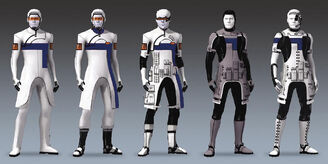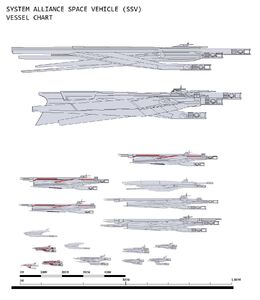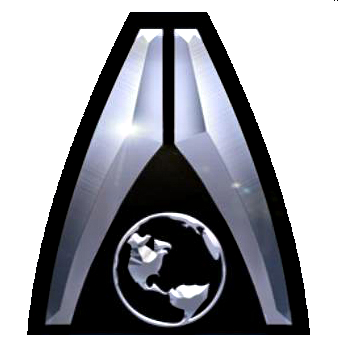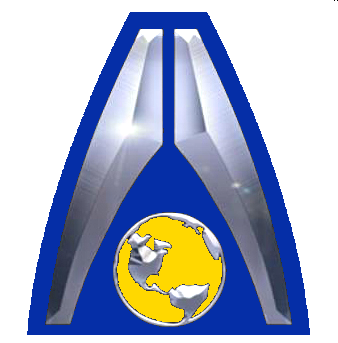|
This article, Alliance Navy (CF2182), was written by Ubernerd101. Please do not edit this fiction without the writer's permission. |
|
This article, Alliance Navy (CF2182), is currently under active construction. |
Alliance Navy is the branch of the Systems Alliance Military responsible for naval operations in outer space. Alliance Navy is the branch of the Systems Alliance Military responsible for naval operations in outer space. Its roles include ship-to-ship combat, orbital bombardment, the deployment of atmospheric and space fighters, and the delivery of Alliance Marines into combat.
Doctrine and Composition[]
The Navy is a peacekeeping and space combat force, charged with protecting human colonies and territory. Alliance military Doctrine is the culmination hundreds of years of violent conflicts.
While the Alliance Fleet sometimes stations small military garrisons on important planets such as Eden Prime, its strength is centered upon powerful fleets and armed taskforces. These Fleets are based in systems with Mass relays nexuses that can rapidly respond to any colony and or territory under attack. The Navy lives by the ancient Chinese General Sun Tzu's teaching, "He who tries to defend everything defends nothing." Garrisons of marines station on key Alliance worlds are intended for scouting rather than defence of the area. The idea is for the garrison to avoid direct confrontation of the hostile force invading the world so to observe and report back to the sector fleet. Once informed of the attack, the fleet stationed at the sectors nexus of mass replays are able to respond with an overwhelming amount of force. Retaking the planet and then taking the fight to the Enemy.
Naval operations, wither in direct combat or supporting ground forces the Alliance Militaries strengths lies within a doctrine of fire support, flexibility, and speed. They Alliance make up for lack of numbers with sophisticated technical support (VIs, drones, artillery, electronic warfare) and emphasis on mobility and individual initiative. This doctrine is not based on absorbing and dishing out heavy shocks like the Turians and Krogan But rather bypassing enemy strong points and launching deep into their rear, cutting supply lines and destroying headquarters and support units, leaving enemies unable to continue effecting military operation.
The human devotion to understanding and adapting to modern space warfare stunned the Council races. For hundreds of years, they had lived behind the secure walls of long-proven technology and tactics. The Council regards the Alliance as a "sleeping giant". Less than 3% of humans volunteer to serve in their military, a lower proportion than any other species.
[]
The Alliance Military has adapted to the galactic stage tremendously, having adopted and improved the overwhelmingly effective ship-to-ship combat practises see across the galaxy. This is do to the creation and utilisation of Mass Accelerators. Ship mobility dominates space combat; the primary objective is to align the mass accelerator along the bow with the apposing vessel's broadside. Battles typically play out as artillery duels fought at ranges measured in thousands of kilometers.
Practical gunnery range is determined by the velocity of the attacker's ordinance and the maneuverability of the target. Beyond a certain range, a small ship's ability to dodge trumps a larger attacker's projectile speed. The largest-ranged combat occurs between dreadnoughts, whose projectiles have the highest velocity but are the least manoeuvrable.
Alliance Naval doctrine has relieve on try and true combat practises that the Citadel races have been utilising for centuries. Although this is not always the case and Fleets of varies commands my employ additional tactics and manoeuvres to off balance and flank opposing fleets, ship to ship combat roles and responsibilities play out as the following:
Opposing dreadnoughts open with main gun artillery duel at EXTREME ranges of tens of thousands of kilometers. The fleet close, maintaining evasive lateral motion while keeping their bow guns facing the enemy. Fighters are launched and attempt to close to disruptor torpedo range. Cautious admirals weaken the enemy with ranged fire and fighter strikes before committing to close action. Aggressive commanders advance so cruisers and frigates can engage.
At LONG range, the main guns of cruisers become useful. Friendly interceptors engage enemy fighters until the attackers enter the range of ship-based GARDIAN fire. Dreadnoughts fire from the rear, screened by smaller ships. Commanders must decide whether to commit to a general melee or retreat into FTL.
At MEDIUM range, ships can use broadside guns. Fleets intermingle, and it becomes difficult to retreat in order. Ships with damaged kinetic barriers are vulnerable to wolfpack frigate flotillas that speed through the battle space.
Only fighters and frigates enter CLOSE' "knife fight" ranges' of 10 or fewer kilometers. Fighters loose their disruptor torpedoes, bringing down a ship's kinetic barriers and allowing it to be swarmed by frigates. GARDIAN lasers become viable weapons, swatting down fighters and boiling away warship armor.
Neither dreadnoughts nor cruisers can use their main guns at close range; laying the bow on a moving target becomes impossible. Superheated thruster exhaust becomes a hazard.
Most ship-to-ship engagements are skirmishes between patrol vessels of cruiser weight and below, with dreadnoughts and carriers only deployed in full-scale fleet actions. Battles in open space are short and often inconclusive, as the weaker opponent generally disengages. Once a ship enters FTL flight the combat is effectively over; there are no sensors capable of tracking them, or weapons capable of damaging them. The only way to guarantee an enemy will stand and fight is to attack a location they have a vested interest in, such as a settled world or a strategically-important mass relay.
Planetary and Mass Relay Assults[]
The crucial choice for any attack through mass relays is how to divide the fleet for transit. The accuracy of a relay's mass-projection depends on the mass being moved and how far it’s going. Any long distance and/or high mass jump will see "drift". That is, a ship may be hundreds or millions of kilometers from its intended drop point, in any direction from the relay.
Distance can't be chosen by admirals, but a relay is told how much mass to transit. For example, if told to move a million metric tons of mass, the relay will scan the approach corridor, find four 250,000-ton freighters, and transit them together, maintaining their relative positions.A commander has the option of moving his fleet as one large, coherent formation that may be wildly off-position, or breaking it up into many smaller formations that will be individually closer to the intended attack point, but could be widely dispersed. Conservative assault doctrine holds that fleets should be moved en masse, maintaining concentration of force and reducing the chances of collision. The only time it is reasonable to split up a formation is during blockade running.
Once a fleet chooses how move the fleet into the attacking system the initial battle out of FTL commences. More likely then not assaulting through a defended mass relays often occur at CLOSE ranges(see Alliance Naval tactics above). "knife fights" as it has been coined, accurse do to the close to medium proximity of opposing vessels stationed in the assaulted system. It is impossible to know where the exact location of the opposing vessesl in relation to the incoming Fleet, which it self can not positively know its exact exit of FTL. This means that Short-range combat vessels such as fighters and Frigates are crucial and should always be present to support and defend more valuable vessels such as Cruisers and Dreadnoughts. This is never more evident then in the opening minutes of the assault, when the fleet needs to redeploy and move into safe firing lines.
Additionally, Planetary assaults are complicated if the target is a habitable world. Do to strict Citadel Conventions the attackers cannot approach the defenders straight on. This is do to the concern that any large kinetic impactors against habitable would result in catastrophic damage to the world and the civilian populace. Therefore the Alliance is forced to rely on unto minute intelligence reports as to the location and deployment of opposing vessels so not to be caught in the open. The fleet needs to determine where the enemy's defences are, so they may approach from an angle that allows them to fire with no collateral damage. Note this is not necessary for hostile worlds that cant support life forms.
Common disoplin and doctrines state that once control of orbit has been lost, the defending garrisons should disperse into the wilderness if not properly defended by heavy fortification and artillery able to attack incoming vessels. This military doctrine is held because once a fleet has orbital superiority, that fleet can bombard surface forces with impunity. The best option for defenders is to hide and collect reconnaissance in anticipation of relief forces. This is a key doctrine and outstanding order to all ground personnel in the case of attack by an outside force.
Given the size of a planet, it is impractical to garrison entire conquered worlds. Fortunately, colonization efforts tend to focus on building up a dozen or fewer areas. Ground forces occupy the spaceports, industrial facilities, and major population centers. The wilderness is patrolled by unmanned aerial vehicles1 and satellite reconnaissance. If a defender unit is spotted, airmobile rapid deployment units and satellite artillery are used to pin down and destroy them.
Fleets Composition[]

In the Alliance Navy, a Fleets is a large contingent of warships assembled and put in charge of defending a specific sector of Alliance space. Stationed at a key mass relay capable of traversing multiple replies to reach a system within hour of deployment.
Although certain fleets may diver slightly in make and size, most Sector Fleets’ numbers 75 Naval Vessels. The Fleet can then be subdivided into a number of Flotillia that fill the rolls of combat, support, and reconnaissance. The Flotillas’ can then be again divided into squadrons and from squadrons into individual vessels.
Notable Alliance Fleets[]
First Fleet Based at Arcturus Station, the First Fleet guards the mass relay connecting to Earth and serves as a reactionary force able to respond to any attack across three different clusters.
Second Fleet Commanded by Admiral Kastanie Drescher during the 2157 First Contact War, the Second Fleet was responsible for the liberation of Shanxi from turian occupation.
Fifth Fleet The Fifth Fleet is also known as the Arcturus Fleet, as it is based at Arcturus Station. Admiral Hackett is the current commanding officer of Fifth Fleet operations.
Personel[]
[]
The Alliance Military Vocational Code system or MVC for short classifies the career path of all serving personnel within the Alliance Fleet, this includes both the Commision and Enlisted personel. The MVC consists of one letter and one number. The letter represents the role or career path the personel is in and the number indictated how perficient he or she is in the role or skill. Therefore a soldier's MVC indicates proficiency and not rank. All 26 letters are used, and numbers run from 1 to 7.
Please see Military Rank under System Alliance: Military Ranks for further details concerning military rank structure withing the Alliance Military and Navy.
Commisioned Officers[]
In the Systems Alliance, any officer is a member of the Fleet who holds a position of authority, charging them with the duties and responsibilities of a specific office or position. Commissioned officers are typically the only persons able to act as the commanding officer of a Naval vessel of any posting. Officers are often commissioned at Alliance Fleet Academy. The Academy commission approximately 700 second lieutenants and ensigns each year during peacetime. Another route to becoming a commissioned officer is through direct commission. Graduates from the service academies are commissioned immediately upon graduation; credentialed civilian professionals such as scientists, nurses, doctors and lawyers are also directly commissioned upon entry into the military or another federal uniformed service.
Enlisted Personel[]
Enlisted personnel occupy the largest percentage of servicemen and women in the Military to perform the day to day operations in the Alliance fleet. In most cases, enlisted service personnel perform jobs specific to their own occupational specialty, as opposed to the more general command responsibilities of Commissioned officers.
Uniforms[]
Uniforms of the Systems Alliance are a distinction of the service within the MIlitary branch of the Systems Alliance Fleet (SAF).

Science Officer, Medical Officer, Technican, Fire and hazard suit, CIC and weapons operator
- Officers Dress Coat
A symbol of an commissioned offices authority on and off Alliance vessel, these coats are light weight, comfortable and a easy symbol of ones statues of position on board a Alliance Vessel. Made of light weight and material, the material allows heat to escape more very effectively allowing it to be worn in Naval combat.
- Working uniforms
prioritize comfort and safety first and thus are the most utilitarian of the Navy uniforms. They are intended for use in FTL capable vessels and in occasions that involve physical labour. Many working uniforms are variations of the service uniforms except with less formal requirements. This category includes Ship Jumpsuits, which are authorized to be worn by members of all ranks.

- Hazard suit
Hazard suits are worn mainly by Alliance Engineers on large or older combat vessels within the Alliance Navy. Meant for extreme environments including burning heat, subzero temperatures, and sudden depressurisation. - Flight suit
A Systems Alliance flight suit is used by Alliance Fighter and intersepter pilots within the Alliance Navy.
Equipment[]
[]
According to record the Systems Alliance Military possessed over two hundred vessels by the out brake of the First Contact War. This number include seven newly design heavy combat vessels designated as “dreadnoughts” after the 20th century sea ships. Its individual vessels range considerably in size and firepower, varying from hundred-meter-long frigates to nearly kilometer-long dreadnoughts. Fleet units are also supported by fighters and dedicated interceptors.

Today the Alliance Fleet was comprised of over 2,500 warships, 1,000 logistical ships and 14,000 Interstellar Fighters.
Logistic and Support[]
Ships under this category are the most divers in size and purpose. Any ship not filling a direct combat role such as recognisant vessels and troop transports fall under this section.
Athabasca Class Freighter
- A large transport freighter used as a support and transport vessel by the navy
- Crew Complement: 9 to 20
- Weapon:none
- Cargo Capacity: 3,500 containers
- Velocity: 35 MGLT, 2,900g, Mass Accelerator drive core
'Kowloon'''' Class Freighter
- A small transport freighter used as a support and transport vessel by the navy
- Crew Complement: 3 to 6
- Weapon:none
- Cargo Capacity: 1,500 containers
- Velocity: 40 MGLT, 1,100g, Mass Accelerator drive core
Kodiak Drop Ships
- Common Alliance shuttle craft
- Crew Complement: 1 or VI
- Weapons: none
- Cargo Capacity: a squad of infantry
- Velocity: 650g
- Alliance shuttle craft used in Special opperation.
- Crew Complement: 1 or VI
- Weapons: Classified
- Cargo Capacity: a squad of infantry
- Velocity: 750g
Polar Heavy Task Transport
- Heavy transport ship designed for tank drops and heavy equipment.
- Crew Complement: 2
- Weapon: Guardian
- Cargo Capacity: 2 heavy tanks or 4 Mako tanks or 6 Walkers or a company of infantry
- Velocity: 400g
Fightercraft and Bombers[]
Fighters are single pilot small combat craft. Their light frame and elemental zero cores make them capable of greater acceleration and manoeuvring then other starships. They are armed with disrupter missiles capable of penetrating kinetic shields. Fighters primarily serve a support role in space battles, either by defending their fleet or swooping in to attack the critical systems of a larger enemy vessel.
Arrow Fighter Bomber
- All perpuse fighter bomber
- Crew Compliment: 2
- Weapon System: 2 Railguns, 6 Torpetos
- Velocity: 100 MGLT, 4,500g
Razor Interceptors
- Common Ship defence craft
- Crew Compliment: 1
- Weapon System: 4 Railguns, 2 Torpetos
- Velocity: 75 MGLT, 4,800g
Frigates[]
These light escort and scouting vessels are roughly 50 meters long and carry a crew of 20. Frigates such as the Normandy are too small to carry fighters, but are equipped with modest main-gun mass accelerators and often have extensive GARDIAN systems to provide anti-fighter screening for larger vehicles. Their drive systems make them more maneuverable than larger starships and allow for higher faster-than-light (FTL) cruise speeds. A squad of marines is carried on board for security and ground-side duty. Unlike larger vessels frigates can land on planets. Alliance Frigate's are named after great battles in human history.
Thermopylae Class, Heavy Frigate
- Crew Compliment: 90
- Weapon Systems: GARDIAN, 4 F-class Mass Accelerators, 2 torpedo tubes.
- Embarking Craft:
- Velocity: 68 MGLT, 3,800g, Mass Accelerator drive core
Hastings Class, Frigate
- Crew Compliment: 80
- Weapon Systems: GARDIAN, 2 F-class Mass Accelerators, 4 torpedo tubes
- Embarking Craft: 2 drop ships
- Velocity: 70 MGLT, 4,000g, Mass Accelerator drive core
Vally Forge Class, Gun Boat
- Crew Compliment: 40
- Weapon Systems: GARDIAN, 2 F-class Mass Accelerators. 6 Railguns.
- Embarking Craft:
- Velocity: 75 MGLT, 4,100g, Mass Accelerator drive core
Normandy Class, Stealth Reconnaissance
- Crew Compliment: 20 (5 officers, 15 crewmen, 5 marines)
- Weapon Systems: GARDIAN, 2 F-class Mass Accelerators.
- Embarking Craft: Mako Land craft
- Velocity: 90 MGLT, 4,300g, Mass Accelerator drive core
Cruisers[]
The cruisers are the infantry of fleets. They are faster than dreadnoughts and more heavily armed than frigates. Fighters are housed in the cruiser's baffles. Their main weapons systems are mass accelerator cannons which can be used at long ranges and as broadside guns. In small engagements they lead frigate groups and in larger ones screen the broadsides of the dreadnoughts. They are fitted with ablative armor and protected by kinetic shields. Alliance Cruiser's are named after cities on Earth.
Berlin Class Cruiser
- Crew Compliment: 180
- Weapon Systems: GUARDIAN, 2 C-class Mass Accelerators, 12 F-class Mass Accelorator, 4 Missiles platforms, 2 torpedoes tubes.
- Embarking Craft: 2 Kodiak Drop ships, 12 Razor Interceptors, 6 Arrow Fighter Bombers.
- Velocity: 65 MGLT, 3,400g, Mass Accelerator drive core
York Class Cruiser
- Crew Compliment: 230
- Weapon Systems: GUARDIAN, 2 C-class Mass Accelerators, 16 F-class Mass Accelorator, 6 Missiles platforms, 2 torpedoes tubes.
- Embarking Craft: 4 Kodiak Drop ships, 12 Razor Interceptors.
- Velocity: 60 MGLT, 2,800g, Mass Accelerator drive core
Mumbai Class Semi dreadnoughts
- Crew Compliment: 330
- Weapon Systems: GUARDIAN, 3 C-class Mass Accelerators, 34 F-class Mass Accelorators, 8 Missiles platforms, 4 torpedoes tubes.
- Embarking Craft: 4 Kodiak Drop ships.
- Velocity: 40 MGLT, 2,000g, Mass Accelerator drive core
Carriers[]
Carriers are dreadnaught sized vessels that carry a large array of small fighter craft and embaraking vessels. Carriers are deployed in a supporting role to the fleet it is assigned to, their armaments are light and they tend to stay in the rear of the fighting. The carrier is a mobile supply and refueling base capable of housing Frigate sized vessels in their hold.
Einstein Class Carrier
- Crew Compliment: 2100
- Weapon Systems: GUARDIAN, 20 Missiles platforms
- Embararking Craft: 20 Kodiak Drop ships, 10 Grizzly Drop Ships, 6 Polar Heavy Transports, 120 Razor Interceptors, 60 Arrow Fighter Bombers, 4 Frigate Class vessels
- Volocity: 860g, Mass Accelerator Drive Core
Dreadnoughts[]
These are the biggest ships in fleets. They are usually 800 meters to a kilometer in length. A squadron of fighters is carried on the dreadnoughts for protection and support. The Alliance System have six with one more under construction. Alliance Dreadnought's are named after mountains on Earth.
- SSV Kilimanjaro
- SSV Aconcagua (under construction as of 2183)
- SSV Elbrus
- SSV Everest
- SSV Fuji
- SSV Shasta
- SSV Tai Shan
Under present Citadel law, Alliance navy can only have a set maximum number of 7 Dreadnought in service at any one time. Although this number may change slightly do to the Geth Crisis; the number is only likely to rise to 9 and the most.
Everest Class Dreadnought
- Crew Compliment: 1250
- Weapon Systems: GUARDIAN, 3 D-class Mass Accelerators, 60 C-class Mass Accelerators, 60 Missiles platforms, 30 torpedoes tubes.
- Embarking Craft: 20 Kodiak Drop ships, 68 Razor Interceptors, 48 Arrow Fighter Bombers.
- Velocity: 900g, Mass Accelerator drive core
Kilimanjaro class Dreadnought
- Crew Compliment: 1115
- Weapon Systems: GUARDIAN, 8 D-class Mass Accelerators, 70 C-class Mass Accelerators, 30 Missiles platforms, 20 torpedoes tubes.
- Embarking Craft: 8 Kodiak Drop ships, 54 Razor Interceptors, 24 Arrow Fighter Bombers.
- Velocity: 900g, Mass Accelerator drive core
Notable Actions[]
Although the System Alliance have not been active among the stars as long the Salarian or the Asari, the Alliance have distinguished themselves on multiple occasions. Listed below are just a few of Alliance military action that have served to strengthen Human interest and they political presence on the galactic stage.
- First Contact War
- Shanxi
- Skyllian Blitz
- Raid on Torfan
- Siege of the Citadel
- Geth Crisis
Military Jargon[]
Please see Military Jargon under the Alliance: Military Jargon System Alliance: Military Jargon for a list of common naval slang and military lingo used throughout the Navy and Alliance Military.
Related Links[]
Behind the Scenes[]
- in Mass Effect Concept Art Book; Human ship, especially those of Alliance make, were drawn to be composed or curved lines and simple shapes leading to a more organinc looking vessels in the Mass Effect Universe.
- Most if not all the Alliance vessels classes were inspired by the work of Masao Okazaki and fan site; “Starfleet Musem”.
- The "Razor" Interceptor was inspired by the Vipers of the re-invisioned Battlestar Galactic series.

